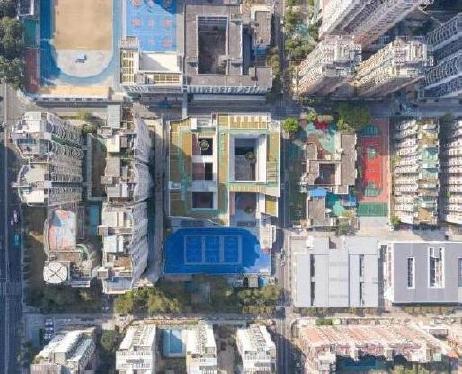The challenge of designing Shixia Primary School is to maintain an appropriate spatial scale under multi-layered and high-density conditions, regulate the intersection of architecture and nature, and allow children to grow together with the courtyard, trees, and grassland. The design utilizes layers of rising steps to form a three-dimensional courtyard space. It is hoped that the opening of Shenzhen’s future campus can lead community citizens from the city square through the large tree courtyard, all the way to the rooftop grass slope, and towards the three-dimensional campus and city of urban courtyard, with an area of 34110 square meters..

Faced with the challenges of area requirements, floor height, and site limitations, the design incorporates multiple forms of outdoor space that run through vertical functional divisions. The upper level is for administrative offices, the middle level is for teaching clusters, and the lower level is for public functions. The teaching space in the middle level starts from the basic class units and forms a class group in combination with the shared corridor space. Three floors are stacked in clusters, with lower grades near the playground and higher grades near the rooftop. The upper level is a continuous rooftop ramp and steps, which can accommodate flower beds, vegetable fields, grass squares, and theater runways. The lower level ground corridor and the hanging space connect the auditorium, musical instruments, books, swimming, and sports hall on the underground level. The ground courtyard, elevated corridors, openings, and skylights provide ample natural lighting for the underground..

Design to plant four large trees in the four courtyards of the campus, bringing green to higher floors. The platform or large steps under the trees form a learning and activity space, and also provide shade to improve the microclimate. The campus design focuses on the cross section relationship between architecture and nature, with open floors and continuous roofs ensuring that each overlapping functional group has sufficient outdoor space, creating a three-dimensional courtyard and interspersed outdoor activities, becoming the prototype of the new generation of high-density vertical composite campus in Shenzhen..

The upper level of the building consists of continuous roof ramps and steps, which can accommodate flower beds, vegetable fields, grassland squares, and theater runways. The ramp rises in an S-shape and reaches its highest point in the northwest corner before slowly descending towards the northeast corner, forming a continuous loop. Classmates take a slow jog or walk on the roof, accompanied by a slowly rising architectural form, to enjoy the landscape changes of a grassy garden and winding ascent..


At the lower level of the sloping roof, the library makes use of the long, high and tortuous ceiling, with the reading shelves of the big steps and french window, and opens windows through the size of the southern wall, so that the moving light and shadow can show the size of the child’s body; The art museum is built on a five story connecting bridge on the east side, combined with shading display panels that rotate and adjust the window edges, forming a large-scale frame view of the campus courtyard as a whole..































